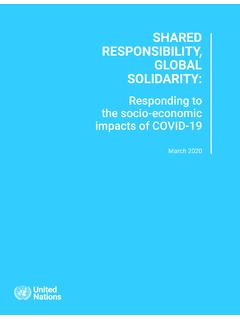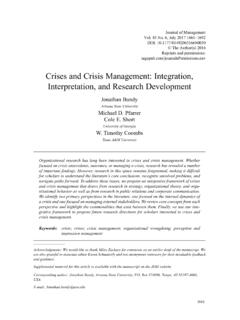Transcription of The Subprime Crisis - OECD
1 ISSN 0378-651X. Financial Market Trends OECD 2008. The Subprime Crisis : Size, Deleveraging and Some Policy Options Adrian Blundell-Wignall *. The paper revises our previous USD 300 bn estimate for mortgage related losses to a range of USD 350-420 bn. In doing this the paper explicitly rejects the previous approach based on implied defaults from ABX pricing, because these prices are affected by illiquidity and extreme volatility; they will likely lead to misleading estimates of losses. Instead it builds a proper default model approach and allows for recovery of collateral via house sales over time.
2 The paper separates out the losses due to commercial banks in the US, and goes on to look at the implied deleveraging required to meet capital standards. It could take 6-12 months for banks to offset losses via earnings alone, depending on Fed rate cuts and the dividend policy of banks. Since even more capital than this is required if banks were to expand their balance sheets, the paper looks at possibilities for capital injections from groups like sovereign wealth funds; and it also looks at a novel plan for the use of public money with an RTC-style approach and the issue of zero coupon bonds.
3 Finally the paper looks at the issues of moral hazard, the likely size of the impact in Europe and Asia and non-bank corporate leverage. * The views expressed herein are those of the author and do not necessarily reflect those of the OECD or the governments of its Member countries. The author is solely responsible for any errors. FINANCIAL MARKET TRENDS ISSN 0378-651X OECD 2008 1. THE Subprime Crisis : SIZE, DELEVERAGING AND SOME POLICY OPTIONS. Executive summary The main focus of this study is to review where we now stand in relation to our September 2007 calculation that the losses from Subprime could amount to USD 300 bn; what the losses mean for deleveraging in the economy; and what policy options there are to deal with the negative economic consequences of deleveraging.
4 Section I of the paper looks at losses calculated with market price methods (the basis of the 2007 work). Liquidity problems and panic are causing major problems for price discovery, rendering this type of approach invalid. Section II therefore looks at default model-based estimates of losses. The estimates from this model, assuming a 40%-50%. range for recovery on defaulting loans and an economic and house price scenario benchmarked against previous episodes, is USD 352-USD 422 bn. To get anything like recent mark-to-market losses (of virtually double our estimate) would require a 0% recovery rate which seems extreme even for the most bearish.
5 Section III focuses on the commercial banking share of the losses and potential transmission through deleveraging by this key sector to the economy, as well as policy options to counter this. About USD 60 bn of direct losses may be put down to US commercial banks and USD 27 bn to investment banking. Four things can happen: (i) commercial bank deleveraging, causing a credit crunch; (ii) banks can earn back the capital (with help from interest rate and dividend policy) and get back to intermediating; (iii) capital can be injected by investors ( sovereign wealth funds and hedge funds); and (iv) public sector intervention can be used to separate problem bonds and mortgages from the intermediation process.
6 It could take at least 6 months (with maximal interest rate and dividend cutting) and possibly up to 1 year (with more pessimistic assumptions on rates and dividends) to replace losses. This is too long for the economy, and risks early 1990s credit crunch scenarios. Capital raisings/injections from risk-taking private institutions or SWFs are a big help. But the arithmetic of getting quickly back to business-as-usual', which requires much more capital than simply offsetting the losses, argues for more action if possible. One such action mentioned in this context is the socialisation of losses.
7 The paper provides a low cost example of a Resolution Trust Corporation-like' ( RTC-like') mechanism. 2. FINANCIAL MARKET TRENDS ISSN 0378-651X OECD 2008. THE Subprime Crisis : SIZE, DELEVERAGING AND SOME POLICY OPTIONS. Section IV looks at US-listed prime brokers/investment banks. Direct holding losses could be around USD 27 bn (warehousing, etc). They are less capitalised and problems for the economy arise through their linkages 1. to other sectors, particularly hedge funds. Moral hazard issues arising from actions taken to date underline that the private sector should be encouraged to do the maximum of which it is capable.
8 These are considered in Section V. Even so, the perceptions that the trade-off between returns-to-risk is now asymmetric must be addressed in the future, and may require more fundamental financial system reforms. Section VI of the paper draws attention to issues for Europe, but does not analyse them in as much detail as for the US. Europe is not immune from the issues raised, and has its own special set of potential problems. It also risks real economy consequences from the Subprime Crisis . Section VII draws attention to Asia, where direct Subprime holdings are relatively less.
9 In Asia, orderly unwinding of bubbles and avoidance of future problems turn on attitudes to exchange rate policy. Section VIII looks at spill-over risks to corporate bonds and equities. While corporate balance sheets are in good shape on average, there is a fat tail of overleveraged companies that will default in the advent of a recession, creating pockets of turmoil in corporate bonds (non-investment grade) and equities. Avoiding such spill over from the mortgage sector is essential, and underlines why a broad approach to policy to minimise the size of the economic impact is required.
10 The macro policies options are summarised in section IX: liquidity support and rate cutting to enhance earnings power of banks; focus on dividend policies; capital injections and M&A from stronger financial institutions; and RTC-like socialisation of losses. I. How big is the Subprime Crisis : previous FMT and now? Was our In the previous issue of Financial Market Trends (FMT), written in USD 300 bn September 2007, USD 300 bn was considered the likely size of the estimate in 2007 2. Subprime and Alt-A mortgage losses. At the time the official views were too small?















